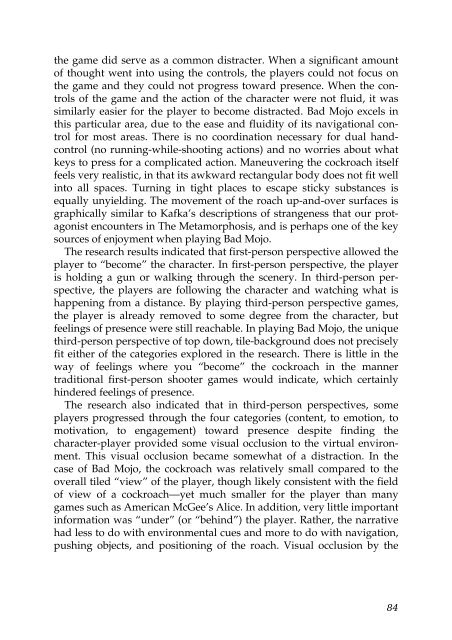Well Played 2.0: Video Games, Value and Meaning - OpenLibra
Well Played 2.0: Video Games, Value and Meaning - OpenLibra
Well Played 2.0: Video Games, Value and Meaning - OpenLibra
You also want an ePaper? Increase the reach of your titles
YUMPU automatically turns print PDFs into web optimized ePapers that Google loves.
the game did serve as a common distracter. When a significant amount<br />
of thought went into using the controls, the players could not focus on<br />
the game <strong>and</strong> they could not progress toward presence. When the controls<br />
of the game <strong>and</strong> the action of the character were not fluid, it was<br />
similarly easier for the player to become distracted. Bad Mojo excels in<br />
this particular area, due to the ease <strong>and</strong> fluidity of its navigational control<br />
for most areas. There is no coordination necessary for dual h<strong>and</strong>control<br />
(no running-while-shooting actions) <strong>and</strong> no worries about what<br />
keys to press for a complicated action. Maneuvering the cockroach itself<br />
feels very realistic, in that its awkward rectangular body does not fit well<br />
into all spaces. Turning in tight places to escape sticky substances is<br />
equally unyielding. The movement of the roach up-<strong>and</strong>-over surfaces is<br />
graphically similar to Kafka’s descriptions of strangeness that our protagonist<br />
encounters in The Metamorphosis, <strong>and</strong> is perhaps one of the key<br />
sources of enjoyment when playing Bad Mojo.<br />
The research results indicated that first-person perspective allowed the<br />
player to “become” the character. In first-person perspective, the player<br />
is holding a gun or walking through the scenery. In third-person perspective,<br />
the players are following the character <strong>and</strong> watching what is<br />
happening from a distance. By playing third-person perspective games,<br />
the player is already removed to some degree from the character, but<br />
feelings of presence were still reachable. In playing Bad Mojo, the unique<br />
third-person perspective of top down, tile-background does not precisely<br />
fit either of the categories explored in the research. There is little in the<br />
way of feelings where you “become” the cockroach in the manner<br />
traditional first-person shooter games would indicate, which certainly<br />
hindered feelings of presence.<br />
The research also indicated that in third-person perspectives, some<br />
players progressed through the four categories (content, to emotion, to<br />
motivation, to engagement) toward presence despite finding the<br />
character-player provided some visual occlusion to the virtual environment.<br />
This visual occlusion became somewhat of a distraction. In the<br />
case of Bad Mojo, the cockroach was relatively small compared to the<br />
overall tiled “view” of the player, though likely consistent with the field<br />
of view of a cockroach—yet much smaller for the player than many<br />
games such as American McGee’s Alice. In addition, very little important<br />
information was “under” (or “behind”) the player. Rather, the narrative<br />
had less to do with environmental cues <strong>and</strong> more to do with navigation,<br />
pushing objects, <strong>and</strong> positioning of the roach. Visual occlusion by the<br />
84

















